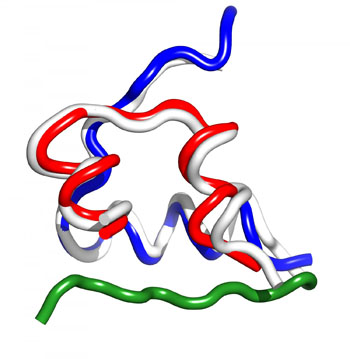Snail Insulin Serves as Drug Development Model
By LabMedica International staff writers
Posted on 22 Sep 2016
A form of insulin isolated from a type of carnivorous marine snail lacks the segment of the B region that causes the protein to aggregate, which decreases the amount of time required by the hormone to influence glucose levels by a factor of three.Posted on 22 Sep 2016
Insulin in the venom of certain fish-hunting cone snails facilitates the capture of prey by rapidly inducing hypoglycemic shock. One such insulin, Conus geographus G1 (Con-Ins G1), is the smallest known insulin found in nature and lacks the C-terminal segment of the B chain that, in human insulin, mediates engagement of the insulin receptor and assembly of the hormone's hexameric storage form.

Image: Comparison of the structures of insulin in Conus geographus (red/white) and in humans (blue/white and green). The green B-chain terminal segment is absent in the C. geographus insulin (Photo courtesy of Dr. Mike Lawrence).
Investigators at the University of Utah (Salt Lake City, USA) reported in the September 12, 2016, online edition of the journal Nature Structural & Molecular Biology that Con-Ins G1 acted as a naturally occurring B-chain-minimized mimetic of human insulin that strongly attached to the human insulin receptor and activated receptor signaling.
The crystal structure of Con-Ins G1 revealed a tertiary structure highly similar to that of human insulin. In addition, the crystal structure suggested that Con-Ins G1 could begin working in as few as five minutes, compared with 15 minutes for the fastest-acting insulin currently available.
"Studying the structure of the cone snail insulin could help researchers modify human insulin to lose its self-aggregation but retain its potency," said contributing author Dr. Helena Safavi, professor of biology at the University of Utah. "Now we can look at the human insulin and see if we can make it more snail-like. People think it is easy to make drugs, but where do you start? You have to have some kind of idea of what a drug should look like, what kind of properties the drug should have, so it is very difficult to design novel drugs. That is why we use the snail venom system."
Related Links:
University of Utah













